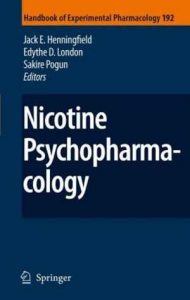نام کتاب: Nicotine Psychopharmacology
نویسنده: Jack E. Henningfield و Edythe D. London و Sakire Pogun
ویرایش: ۱
سال انتشار: ۲۰۰۹
کد ISBN کتاب: ۳۵۴۰۶۹۲۴۶۰, ۹۷۸۳۵۴۰۶۹۲۴۶۱, ۹۷۸۳۵۴۰۶۹۲۴۸۵,
فرمت: PDF
تعداد صفحه: ۵۴۵
حجم کتاب: ۵ مگابایت
کیفیت کتاب: OCR
انتشارات: Springer
Description About Book Nicotine Psychopharmacology From Amazon
The fact that tobacco ingestion can affect how people feel and think has been known for millennia, placing the plant among those used spiritually, honori?cally, and habitually (Corti 1931; Wilbert 1987). However, the conclusion that nicotine – counted for many of these psychopharmacological effects did not emerge until the nineteenth century (Langley 1905). This was elegantly described by Lewin in 1931 as follows: “The decisive factor in the effects of tobacco, desired or undesired, is nicotine. . . ”(Lewin 1998). The use of nicotine as a pharmacological probe to und- stand physiological functioning at the dawn of the twentieth century was a landmark in the birth of modern neuropharmacology (Limbird 2004; Halliwell 2007), and led the pioneering researcher John Langley to conclude that there must exist some “- ceptive substance” to explain the diverse actions of various substances, including nicotine, when applied to muscle tissue (Langley 1905). Research on tobacco and nicotine progressed throughout the twentieth century, but much of this was from a general pharmacological and toxicological rather than a psychopharmacological perspective (Larson et al. 1961). There was some attention to the effects related to addiction, such as euphoria (Johnston 1941), tolerance (Lewin 1931), and withdrawal (Finnegan et al. 1945), but outside of research supported by the tobacco industry, addiction and psychopharmacology were not major foci for research (Slade et al. 1995; Hurt and Robertson 1998; Henning?eld et al. 2006; Henning?eld and Hartel 1999; Larson et al. 1961).
درباره کتاب Nicotine Psychopharmacology ترجمه شده از گوگل
این واقعیت که مصرف دخانیات می تواند بر احساس و تفکر افراد تأثیر بگذارد ، از هزاره پیش شناخته شده است ، و گیاه را در زمره گیاهان مورد استفاده معنوی ، افتخاری و عادت قرار می دهد (کورتی ۱۹۳۱ ؛ ویلبرت ۱۹۸۷). با این حال ، نتیجه گیری که نیکوتین برای بسیاری از این اثرات روانی-فارماکولوژیکی حساب می شود ، تا قرن نوزدهم پدیدار نشد (لانگلی ۱۹۰۵). لوین در سال ۱۹۳۱ با ظرافت اینگونه شرح داد: «عامل تعیین کننده در اثرات تنباکو ، مورد نظر یا ناخواسته ، نیکوتین است. . . ”(لوین ۱۹۹۸). استفاده از نیکوتین به عنوان یک پروب دارویی برای درک عملکرد فیزیولوژیکی در طلوع قرن بیستم ، نقطه عطفی در تولد نورو فارماکولوژی مدرن بود (لیمبرد ۲۰۰۴ ، هالیول ۲۰۰۷) ، و محقق پیشگام جان لنگلی را به این نتیجه رساند که وجود برخی از “- مواد مهمی” برای توضیح اقدامات مختلف مواد مختلف ، از جمله نیکوتین ، هنگام استفاده بر روی بافت عضلانی (لانگلی ۱۹۰۵). تحقیقات در مورد دخانیات و نیکوتین در طول قرن بیستم پیشرفت کرد ، اما بیشتر این از دیدگاه عمومی دارویی و سم شناسی بود تا روان درمانی (لارسون و همکاران ۱۹۶۱). برخی از تأثیرات مربوط به اعتیاد مانند سرخوشی (جانستون ۱۹۴۱) ، تحمل (لوین ۱۹۳۱) و ترک (فینگان و همکاران ۱۹۴۵) مورد توجه قرار گرفت ، اما خارج از تحقیقات پشتیبانی شده توسط صنعت دخانیات ، اعتیاد و روان درمانی کانونهای اصلی تحقیق (اسلید و همکاران ۱۹۹۵ ؛ هرت و رابرتسون ۱۹۹۸ ؛ هنینگ؟ الد و همکاران ۲۰۰۶ ؛ هنینگ؟ الد و هارتل ۱۹۹۹ ؛ لارسون و همکاران ۱۹۶۱).
[box type=”info”]![]() جهت دسترسی به توضیحات این کتاب در Amazon اینجا کلیک کنید.
جهت دسترسی به توضیحات این کتاب در Amazon اینجا کلیک کنید.![]() در صورت خراب بودن لینک کتاب، در قسمت نظرات همین مطلب گزارش دهید.
در صورت خراب بودن لینک کتاب، در قسمت نظرات همین مطلب گزارش دهید.

